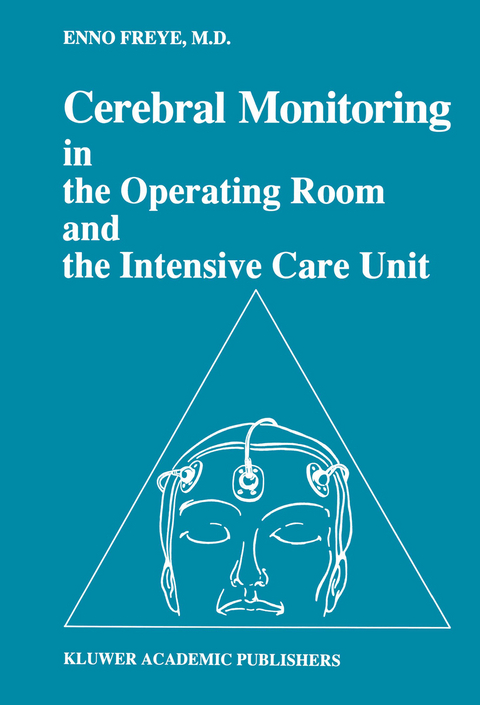
Cerebral Monitoring in the Operating Room and the Intensive Care Unit
Springer (Verlag)
978-94-010-7341-7 (ISBN)
1. Introduction.- 1.1 Rationale for the use of cerebral monitoring in the OR and the ICU.- 1.2 Why monitor the brain.- 1.3 The neurological approach to EEG interpretation.- 2. The principle of EEG recording using computerized power spectral analysis.- 2.1 Difference with conventional EEG recording.- 2.2 Electrode placement.- 2.3 Technical requirements to obtain a reliable EEG signal (amplifiers, filters).- 2.4 The recording procedure.- 2.5 Display techniques of the EEG.- 2.6 Artifact rejection during processed EEG measurement.- 2.7 Signal conduction and conversion.- 3. Set-up of monitoring the EEG: The electrode montage.- 4. Anesthesia and the EEG.- 4.1 Rationale for the use of the EEG in anesthesia.- 4.2 Inhalational agents and their effect on the EEG (N2O, halothane, enflurane, isoflurane).- 4.3 Intravenous agents and their effect on the EEG (barbiturates, etomidate, ketamine, opioids, benzodiazepines, propofol, CO2).- 5. The EEG and cerebral ischemia.- 5.1 Differentiation between ischemia and anesthetic-induced EEG changes.- 5.2 Cerebral monitoring during hypothermia and extracorporeal circulation (ECC).- 5.3 EEG monitoring during carotid endarterectomy.- 6. Cerebral monitoring in the intensive care unit.- 6.1 Introduction: Representative case reports.- 6.2 EEG power spectra to differentiate between severe head trauma and drug overdose.- 6.3 Symptoms of irreversible cessation of functions of the brain including the brain stem.- 6.4 Avoiding false interpretation of EEG signal.- 6.5 EEG power spectra during sleep.- 7. Trouble shooting.- 8. Systems currently available for processed EEG recording.- 8.1 Introduction.- 8.2 Description of units used for EEG power spectral analysis in the OR and the ICU.- 9. Sensor Evoked Potentials (SEPs).- 9.1 What they are and what they offer.- 9.2 Rationale for the use of EPs in the OR and the ICU.- 9.3 The classification of EPs.- 10. The principle of Somatosensory Evoked Potential monitoring.- 10.1 Electrode types.- 10.2 Procedure for locating the exact stimulus site.- 10.3 The stimulus necessary for SEP recording.- 10.4 Recording electrodes.- 10.5 Procedure for head measurements to determine electrode location.- 10.6 Accessory for electrode placement and removal.- 10.7 Connection of electrodes with the preamplifier.- 10.8 Trouble shooting to eliminate high impedance and electrical noise.- 10.9 The differential amplifier for EEG and EP measurements.- 11. Optimising signal to-noise ratio.- 11.1 Introduction.- 11.2 Procedure to locate the optimal stimulus site.- 11.3 Alternating recording and stimulus sites.- 12. Evaluating the response of the evoked potential.- 12.1 Median nerve evoked potential.- 12.2 The posterior tibial nerve evoked potential.- 12.3 Criteria for abnormalities of both median and posterior tibial evoked potential.- 13. The effect of drugs on the evoked potential.- 13.1 Application of SEP monitoring in the clinical setting.- 13.2 Representative examples of SEP traces at different clinical situations.- 13.3 Postoperative use of SEPs.- 14. Use of evoked potentials in the ICU.- 14.1 Introduction.- 14.2 SEPs in the diagnosis of lesions in the plexus of the upper extremities and in cervical root lesions.- 14.3 Use of SEP monitoring in head trauma, vascular disease, and brain death.- 14.4 Pitfalls and pointers for SEP measurement in the OR and the ICU.- 15. Auditory Evoked Potentials (AEPs) and Brainstem Auditory Evoked Response (BAER or BAEP).- 15.1 Auditory Evoked Potentials.- 15.2 Clinical applications of BAER.- 16. Visual Evoked Potentials (VEPs).- Summary on the application of intraoperative EP monitoring.- 17. Complications that arise during EP monitoring.- 18. Systems of use for EP measurements in the OR and the ICU.- 19. New scopes in cerebral monitoring by topographic mapping of EEG-power spectra and EP waves.- 20. Appendix.- 20.1 Care of electrodes.- 20.2 Summary of the clinical applications of EP monitoring in the OR.- 20.3 Summary of the clinical applications of EP monitoring in the ICU.- 21. Glossary.- 22. Bibliography.- Index of subjects.
| Reihe/Serie | Developments in Critical Care Medicine and Anaesthesiology ; 22 |
|---|---|
| Zusatzinfo | X, 197 p. |
| Verlagsort | Dordrecht |
| Sprache | englisch |
| Maße | 155 x 235 mm |
| Themenwelt | Sachbuch/Ratgeber ► Natur / Technik ► Garten |
| Medizin / Pharmazie ► Medizinische Fachgebiete ► Anästhesie | |
| Medizin / Pharmazie ► Medizinische Fachgebiete ► Chirurgie | |
| Medizin / Pharmazie ► Medizinische Fachgebiete ► Intensivmedizin | |
| Naturwissenschaften ► Biologie ► Zoologie | |
| ISBN-10 | 94-010-7341-4 / 9401073414 |
| ISBN-13 | 978-94-010-7341-7 / 9789401073417 |
| Zustand | Neuware |
| Haben Sie eine Frage zum Produkt? |
aus dem Bereich


